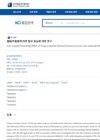TLDR SM-215 promotes hair growth by improving the environment around hair follicles.
The study from 2015 examined the impact of a natural compound, SM-215, on hair growth in 30 ICR mice, which were divided into three groups of 10 each: a control group, a non-treatment group, and an SM-215 application group. The SM-215 was applied topically at a dose of 100μl/day for 3 weeks. The findings indicated that the SM-215 application group experienced an increase in hair and hair follicles, sebum secretion, and sebaceous glands, as well as an increase in capillaries and vasodilation around the hair follicles. There was also a notable increase in growth-promoting hormones, serotonin, and neuropeptide Y in the SM-215 group compared to the non-treatment group. The study concluded that SM-215 enhances hair growth by improving the environment around hair follicles and stimulating them, suggesting that herbal medicine like SM-215 could be an effective component in hair growth treatments.
 349 citations
,
January 2005 in “The FASEB journal”
349 citations
,
January 2005 in “The FASEB journal” Human skin can make serotonin and melatonin, which help protect and maintain it.
 1 citations
,
January 2004 in “Journal of Physiology & Pathology in Korean Medicine”
1 citations
,
January 2004 in “Journal of Physiology & Pathology in Korean Medicine” Thuja orientalis extract significantly promotes hair growth in mice with hair loss.
4 citations
,
January 2004 DanGuiBoHyulTangGami-Bang helps hair growth but doesn't extend the growth period or affect hair follicle cells significantly.
 190 citations
,
October 2002 in “The FASEB journal”
190 citations
,
October 2002 in “The FASEB journal” Androgens may cause hair loss by increasing TGF-beta1 from scalp cells, which inhibits hair cell growth.
 37 citations
,
January 2002 in “British journal of dermatology/British journal of dermatology, Supplement”
37 citations
,
January 2002 in “British journal of dermatology/British journal of dermatology, Supplement” Apple extract called procyanidin B-2 was found to greatly increase hair growth.
 7 citations
,
October 2000 in “Allergo Journal”
7 citations
,
October 2000 in “Allergo Journal” Stress may affect hair growth by influencing hair follicle development and could contribute to hair loss.
 1113 citations
,
August 1999 in “The New England Journal of Medicine”
1113 citations
,
August 1999 in “The New England Journal of Medicine” Hair follicle biology advancements may lead to better hair growth disorder treatments.
 25 citations
,
January 1998 in “Dermatology”
25 citations
,
January 1998 in “Dermatology” Male pattern hair loss negatively affects quality of life, but drug treatments can help.
173 citations
,
July 1995 in “Biochemical and biophysical research communications” Male hormones promote hair cell growth by using a growth factor from nearby skin cells.
 August 2014 in “Journal of clinical & experimental dermatology research”
August 2014 in “Journal of clinical & experimental dermatology research” Platelet-released growth factors can treat hair loss by activating hair follicle stem cells, blocking certain pathways, and controlling inflammation and fibrosis.
 8 citations
,
September 2003 in “Journal of dermatological science”
8 citations
,
September 2003 in “Journal of dermatological science” Substance P helps hair grow longer and faster.
 15 citations
,
April 2001 in “Journal of Dermatological Science”
15 citations
,
April 2001 in “Journal of Dermatological Science” KF19418 promotes hair growth similarly to minoxidil but is not better in live mice.










